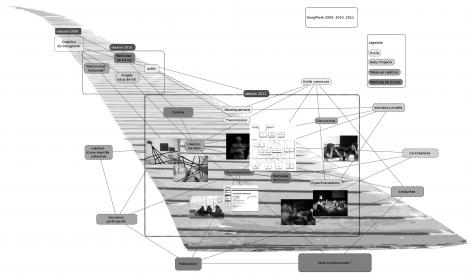Gangplank and the emergence of an open source and interdisciplinary dramaturgy by Anne Goldenberg* (translated by Gangplank members)
Expanding the field of free culture
The "free culture" was first defined in the field of informatics with the creation of license guaranteeing freedom to (0) use (1) study, (2) distribute and (3) change a software program. By "expending the field of free culture", we mean that this philosophy applies and inspires other spheres of activity. In that sense, art would be the last area affected by free culture as a movement. There are different ways of understanding the expansion of a free culture movement within the art.
A first way to look at it could be the extension of the use of free softwares, as well as the diversification of the available tools. Often developed by and for experts users, the first free softwares were for informatics related uses. Gradually, developers have equipped more and more distant tasks such as word processing, documentation techniques, design. It is only recently that developers working with artists and artists-developers began to largely develop free tools.
We can also look at the extension of the free culture with the status accorded to any creations. The philosophy of free software was, from the beginning, a reflection on the nature of knowledge, creation and ideas. So it is no longer just the tools but all productions (ideas, creations, concepts) that are affected by this proposal. As such, several activists defend the idea that the movement launch by free software is not an innovation but a return to pre- capitalism, when this ideology wasn't voraciously applying its logics to all the productions of the mind. The wave of copyrights, patents and other forms of privatization for purposes of private profit and commercialization, comes blocking the natural circulation of ideas, while presenting themselves as the new standard to follow.
Another form of free culture activism is related to the modes of exposure, distribution, access and development of creations. Following the free licenses developed by the world of software (eg GPL, General Public License) other licenses appeared more suited to the diversity of free creations (the Art Libre License, some Creative Commons licenses, the GFDL – GNU Free Documentation License ...).
But a third form of extension of the free culture is probably being set-up by its appropriation and manipulation by the artists. They perform a sensitive, multiform and intimate exploration of the scope, the ecology, the logics of restructuring suggested by the principles of the free culture. Consequently, tools, licenses and productions, but also working methods and modes of exposure become questions of political, epistemic and aesthetic investigation.
Some artists are therefore critical about the implementation of “a so called free culture attitude” without a deep understanding of its philosophy and implications:
"So much "open source" media works and artistic software are being dumped on-line, which supposedly makes them "open" but they are incomprehensible and undocumented, so they remain closed for most people. Participation is the key, and that means that not only the end result is shared, but the whole process." Femke Snelting / Maja Kuzmanović, FLOSS+Art, p.27
Beyond the question of the format, free culture and free art refers to a new modality of work, as well as new forms of material:
"The artist works to change our perception of the world. She digs into the medium and techniques she has chosen, experimenting and developing new ways and visions. Whether this is paint, stone or code, the process is the same [and is] indissociably linked to the world that we create." Solers, FLOSS+Art, p.16.
For Nancy Mauro-Fludir, the tools we use, our working methods and modes of expression configure our world view and our relationships. Citing Loss Peqeño Glazier (1997), she stressed that "the language you are breathing becomes the language you think". Thus, by her or his work, the artist takes part in the creation of a semantic system working as a language. "Our ability to create, plan and code our environment makes us responsible for what we create and for how we choose to live in that creation." Mauro-Flude, FLOSS+Art, p.220. .
Several members of Gangplank sharply fall in this line of reflection. For Aniara Rodado, a dancer, director and choreographer working with free software, the use of proprietary technologies in digital creations limits creativity and homogenize productions. Aniara stresses that "simplified interfaces give the illusion of immediate autonomy, but do not lead to a true understanding of systems, neither the search for help nor a dialogue between technicians and artists." This is one reason why free software inspires interdisciplinary and horizontal modes of creation. Olivier Heinry, multimedia artist and performer involved in the organizing of Gangplank notes that "if horizontal processes are integrated from the start, everyone knows that the possibilities of adjustment are collective." Also, certain artistic practices were faster than others to raise awareness for the free culture philosophy. Practices that incorporate the use of softwares and technologies were perhaps touched before others by free software philosophy, but the social functioning of each creative discipline would also be involved. For instance, according to Aniara, dance has a history of horizontal and co-creation that theater has not, (more rooted in hierarchies between directors and actors, between artists and technicians). This is reflected in the adoption of the philosophy of free culture.
Gangplank's first steps
A gangplank is a movable plank used to board or disembark from a ship or boat. Born in 2009 from a desire to explore free culture applying to live arts and to break the usual boundaries of expertise, Gangplank (GK) was organized around four dimensions:
1 – Create an interdisciplinary link: the Gangplank wants to allow a bridge between disciplines, practitioners, artists, technicians, specialists, hackers, experts and beginners who work in live arts ;
2 – Give birth to joint projects: this desire is embodied in the constitution of collective projects, and a link to support lasting ties. In this, Gangplank wants to be a project of solidarity, a platform for participants to give an artistic and technical support to each other ;
3 - Develop free tools: the development and dissemination of free software tools for live arts is one of the central goal of the project. Participants create, experiment, share and document tools for the manipulation of light, sound and video (including the Matrix, developed with puredata) that allows for example to connect a web-cam or a MIDI controller to a Lanbox ;
4 - Produce technical and methodological documentation : this interdisciplinary way of working is also an opportunity to reflect upon and transmit knowhow about working methods, collaboration issues and communication modes. The project is also based on the desire to analyze the processes induced by those interdisciplinary artistic processes in order to share with the others members of the artistic community.
Facilitation and documentation of spatial arrangements
Devices of visualization
The workshops which were held from June 13 to 26, 2011 in Aubervilliers were the third meeting session of Gangplank. On this occasion, the organizers have proposed to invite a sociologist and facilitator (myself) to study the project and work with collaborative methods.
After discussions with Olivier Heinry, I suggested to use the walls of the working space as a medium for documenting the activities of the session. This documentation would then become a medium of exposure of Gangplank for the open doors on the 18th and 25th of June. In this double perspective of documentation and exhibition, we gave ourself three watchwords – readability, usability and enjoyment. We started with five devices of visualization:
• A wall calendar for the proposal and planning of collective activities of Gangplank (the Agenda) 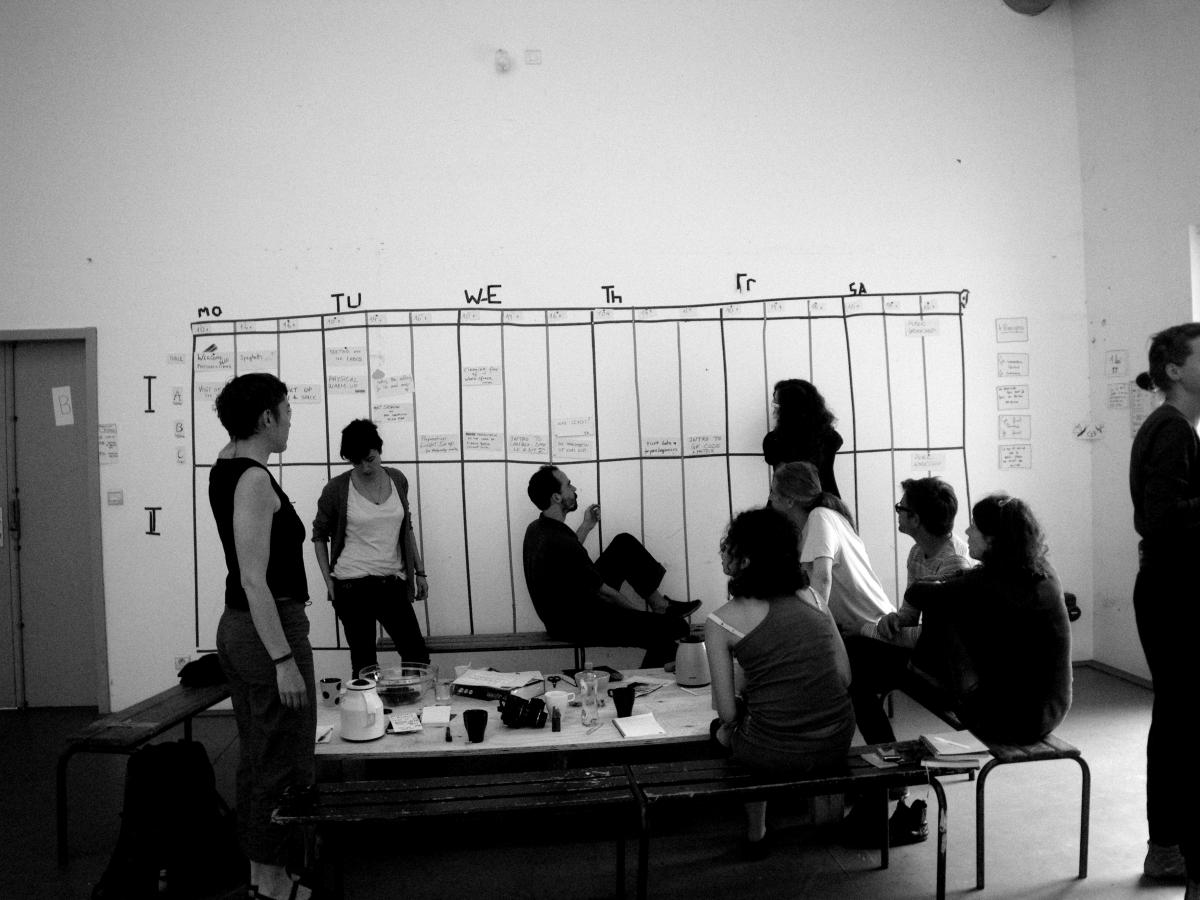
Agenda ©Gangplank
• A wall dedicated to the presentation of past sessions (the Wall of the Past)
• A mind map of the evolution of the concepts. This mind map was first proposed as an installation in three dimensions, but for reasons of lack of fluidity, the project was abandoned in favor of one large wall dedicated to the exhibition paper documentation of activities (the Documentation Wall)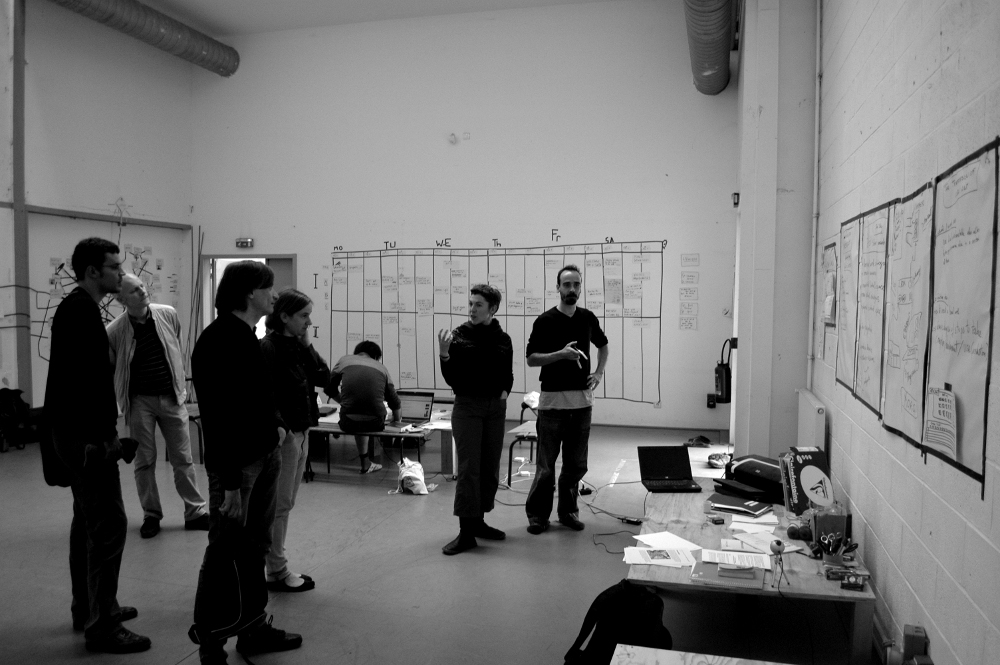
Documentation Wall ©Gangplank
• A small space dedicated to proposing ideas thoughts on the session in progress (the Meta Corner) 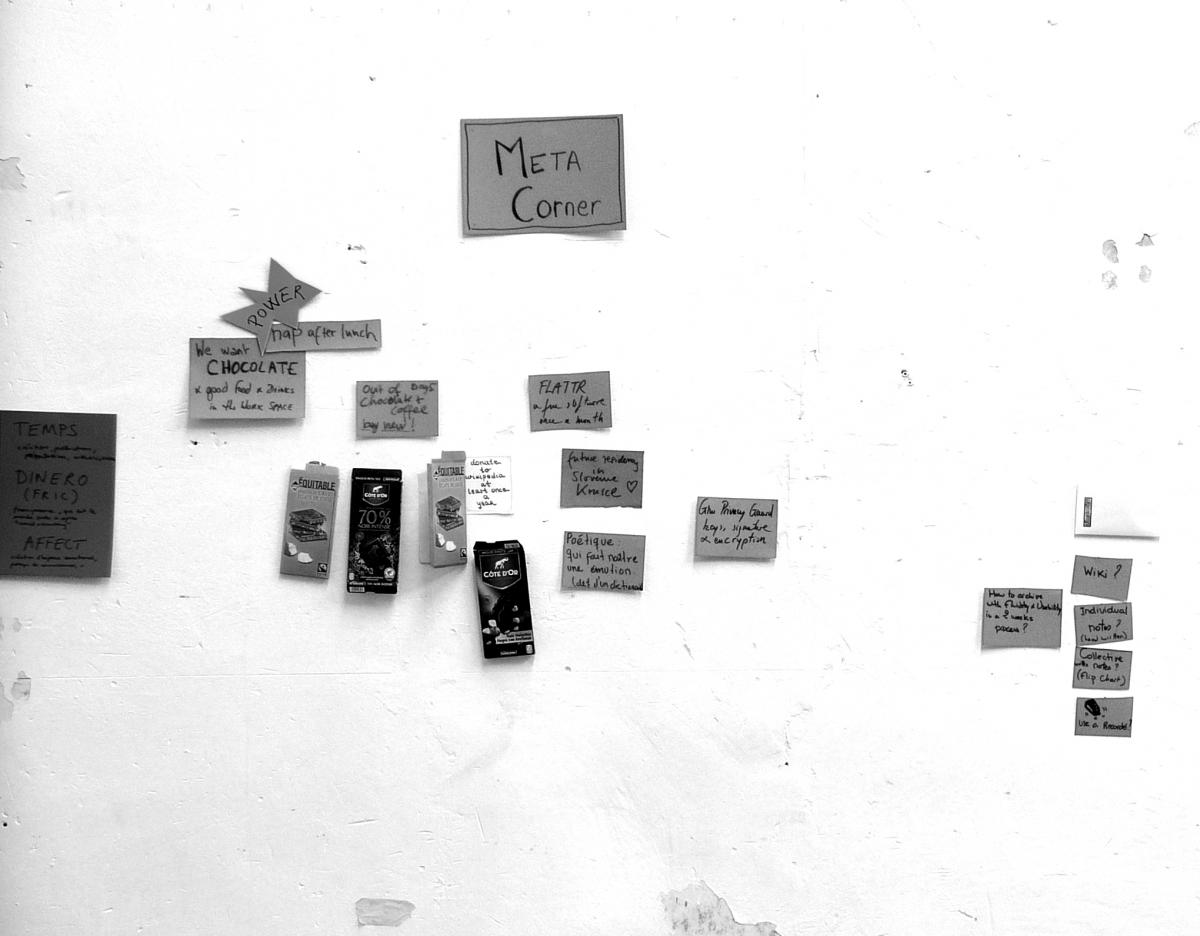
Metacorner ©Gangplank
• A map for the presentation of (past and present) participants to Gangplank and how they link among each-others (the Wall of Passengers)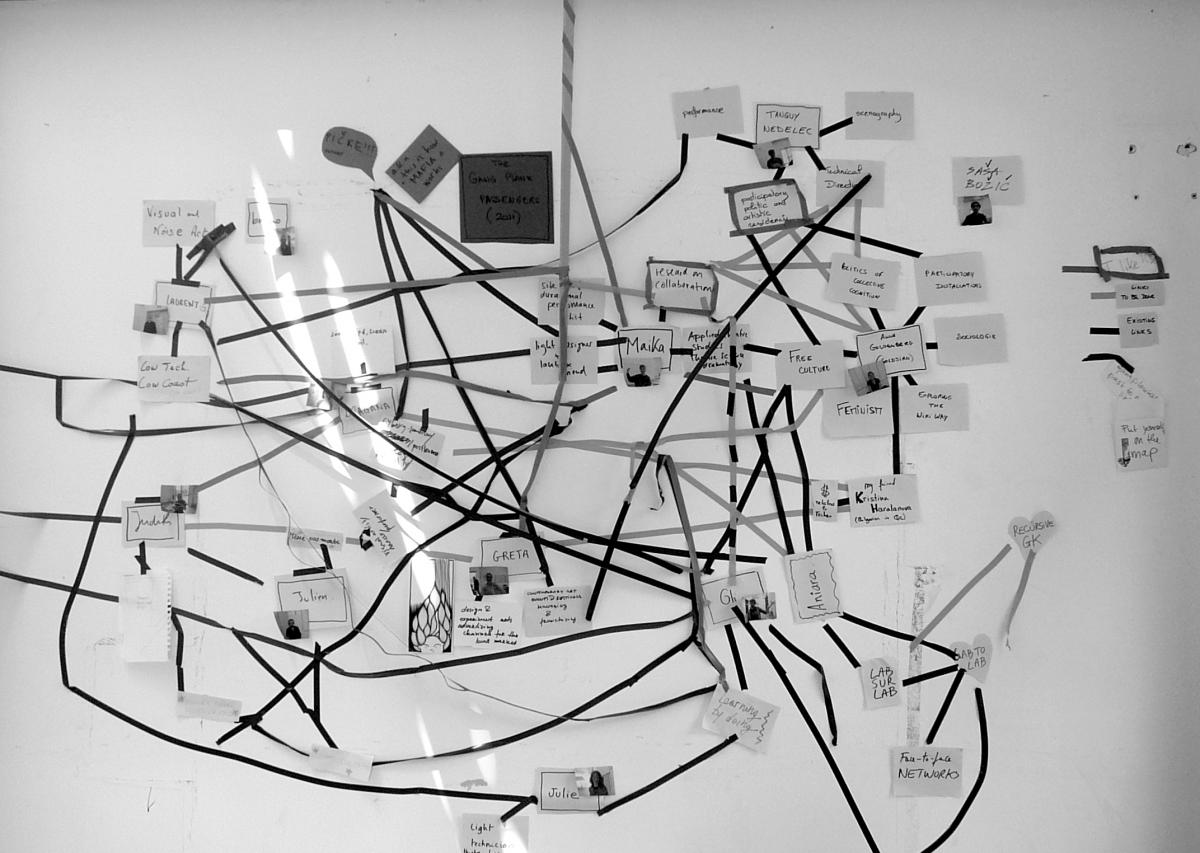
Wall of Passengers ©Gangplank
To these proposals were then added others:
• A wall of things to do in a short term or middle term (The To-Do and Wishes List)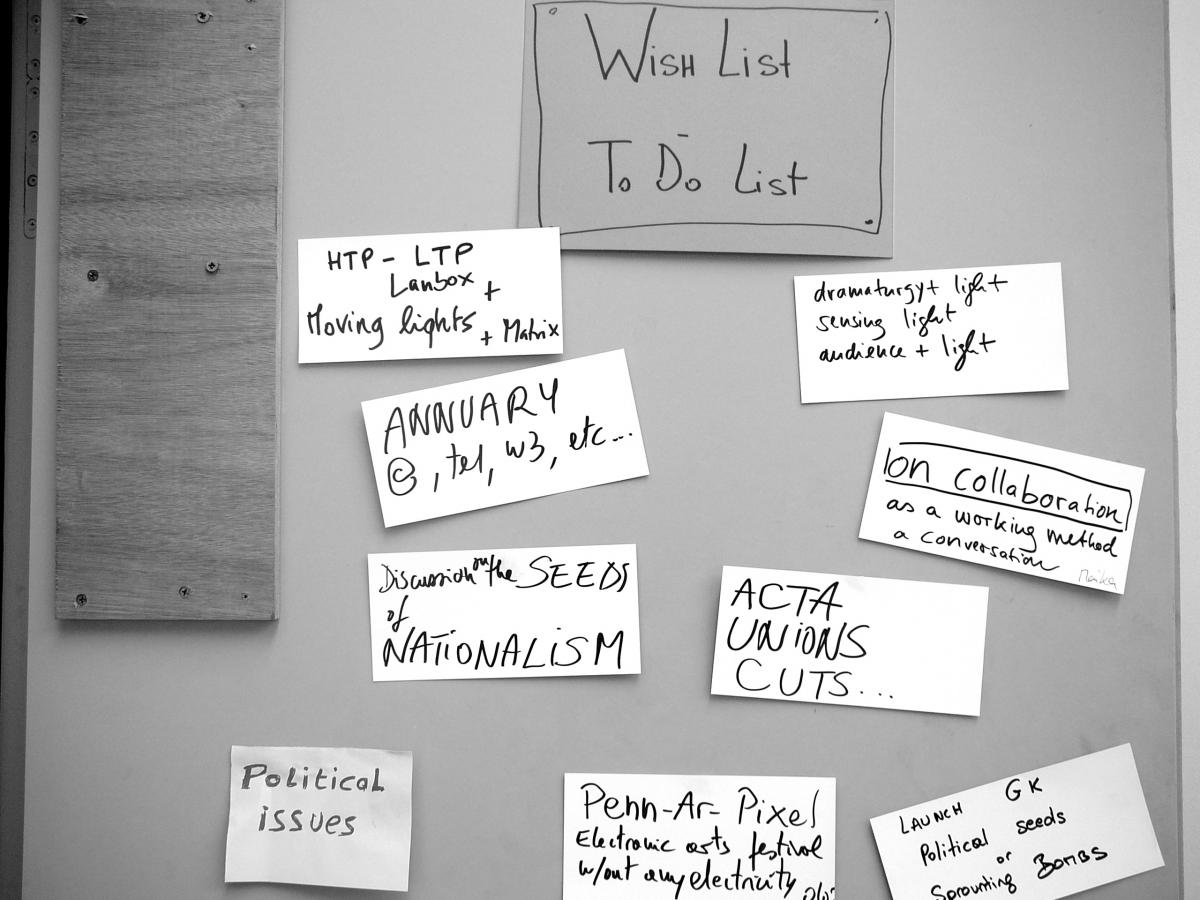
The To Do and Wishes List ©Gangplank
• The Vademecum¹ (short guide to take with you to Gangplank) with the help of the Booki platform. The goal is to guide new users with GK's tools as well as a repository of the group's reflections. This project should be completed by the next session of Gangplank held in Essen in July 2011.
The devices and their uses
The devices have been used unevenly. The collective agenda (inspired by the Open Space Technology²) immediately facilitated the organization of activities although a differentiation of types of tasks.
The Meta Corner and To-Do and Wishes List were used as a collective block notes for the current reflexions and discussions that were desirable.
From the second week, participants discovered the Booki platform, a collaborative editing tool that facilitate the production of a on-line manual. Considering the need of passing on technical, methodological and dramatic know-how and reflexion, the group first elaborated a table of contents and then divided into small teams to discuss and to write chapters of the Vademecum.
Affinity group or emerging community³?
The role of technology within a collective becoming heterogeneous
The question of transmission began to echo with a growing awareness. How to deal with the heterogeneity of the group induced by the arrival of new people, to whom it is necessary to transmit knowledge and know-how. For example, how to transmit the basics of the tools developed by Gangplank without being too much repetitive and to give space for collective exploration?
The elders (and more technicians) of the group reached this complex position _ starting to threaten, in spite of themselves, the horizontal relationships among participants would be compromised when putting themselves in the position of transmitter toward the new comers, they were creating a high dependency on knowledge creation in the group. This position was particularly difficult to maintain as those elders also needed time for them to advance the tools of the Gangplank project. At this point, a way to bring back horizontal dynamics in the group was to underly the complementarity aspect of relationships, legitimize the knowledge of "beginners", their artistic skills in creative, aesthetic, analytical areas other than purely technical learning. Writing a glossary about contemporary dramaturgy practices and tools, thinking about the relationship between live arts and the audience, or working with peers of beginners and experts to ensure the level of comprehension of a chapter of technical documentation, were various proposals to even the relations.
Community of practice and epistemic community
The transmission of skills, especially the technical ones, for Gangplank newcomers has had another structuring effect: one to initiate the transition from a small homogeneous group identity to that of collective beginning to think in terms of community. Or rather, the beginning of a working shift from a community of practice to an epistemic community. This distinction, subtle and non-radical (the two types of communities often overlap) is a useful factor to understand the status of knowledge and its transmission. In a study on the evolution of the Linux community, Cohendet Patrick et al. (2003) set out the characteristic features of this different types of community :
A community of practice brings together passionate amateurs and experts to increase their skills in a given practice. The representations of this community are homogeneous. They perform an accumulation of knowledge about these practices and circulate the best of them. In this case, the production of knowledge is involuntary.
An epistemic community is deliberately oriented towards the production of knowledge. Its members are heterogeneous, they transform the accumulation of knowledge in an attempt to create a readable and organized knowledge toward an interested audience. The production of knowledge becomes the aim and members begin to think of ways to share what they know.
Toward a community?
The motivations given to the participation to Gangplank at Aubervilliers were the following: to find low-tech collaborative ideas, to reflect on the evolution of Gangplank as a collective and its working methods, the possibilities of interdisciplinary live arts, to explore the role of light for dramaturgy, to develop new tools, to analyze the links between arts and free software, to understand the different tools used by Gangplank, to find ways to fund the contemporary live arts, to better apprehend what are free softwares, to make new inspiring connections, to explore the political dimensions of free culture in the world of art.
The discussions at the end of two weeks suggested that Gangplank is getting bigger and more heterogeneous with a need to think upon how to transmit knowledge. The writing of the Vademecum was seen as an opportunity to stabilize and advance the software documentation and the GK's methodologies. Going toward an epistemic reflexion does not remove the profound practical dimension of the project, its experimental prospects and needs of software development.
The diaporama attached to this article is sketching a picture of the evolution of the collective. Inspired by the (abandoned) project of producing a three dimensional representation on the progression of Gangplank, I tried to lend myself to the exercise by focusing on four founding dimensions: tools, methodological reflection, production projects and creation of links. The elements that emerge from the bridge are those that are visible from an outside public. What they have in common are to constitute a group effort of reflection, formatting, clarification, and to feed the formation of a community of knowledge generation. Finally, it should be understood that this diagram is incomplete, as another Gangplank session began July 18, 2011, which is already changing the representation of the project.
References:
• Cohendet, Patrick et al, 2003, «Innovation organisationnelle, communautés de pratique et communautés épistémiques: le cas de Linux», Revue française de gestion 5/2003 (n° 146), pp. 99-121. URL: www.cairn.info/revue-francaise-de-gestion-2003-5-page-99.htm
• Goldenberg, Anne, 2006, «Extensions du domaine du libre: régimes et Controverses». URL: http://cmo.uqam.ca/sites/cmo.uqam.ca/files/files/Goldenberg_acfas2006.pdf
• Mansoux, Aymeric et de Valk, Marloes, 2008, FLOSS+Art, 320 p. URL: http://people.makeart.goto10.org/
• Mauro-Flude, Nancy, «Linux for Theatre Makers: Embodiment and *nix modus operandi». URL: www.scribd.com/doc/52419877/15/Nancy-Mauro-Flude
Text published in Le Journal des Laboratoires, Sept-Dec. 2011
Normal
0
21
false
false
false
FR
X-NONE
X-NONE
MicrosoftInternetExplorer4
/* Style Definitions */
table.MsoNormalTable
{mso-style-name:"Tableau Normal";
mso-tstyle-rowband-size:0;
mso-tstyle-colband-size:0;
mso-style-noshow:yes;
mso-style-priority:99;
mso-style-qformat:yes;
mso-style-parent:"";
mso-padding-alt:0cm 5.4pt 0cm 5.4pt;
mso-para-margin:0cm;
mso-para-margin-bottom:.0001pt;
mso-pagination:widow-orphan;
font-size:11.0pt;
font-family:"Calibri","sans-serif";
mso-ascii-font-family:Calibri;
mso-ascii-theme-font:minor-latin;
mso-fareast-font-family:"Times New Roman";
mso-fareast-theme-font:minor-fareast;
mso-hansi-font-family:Calibri;
mso-hansi-theme-font:minor-latin;
mso-bidi-font-family:"Times New Roman";
mso-bidi-theme-font:minor-bidi;}
* Anne Goldenberg is a french-quebecois researcher and facilitator working on politics of knowledge production.
¹ http://www.booki.cc/gangplank-vademecum/
² http://www.openspaceworld.org/
³ The notion of community is used here to in the North American sense of open gathering around a common project rather than European sense of closetering within a identity circle.


